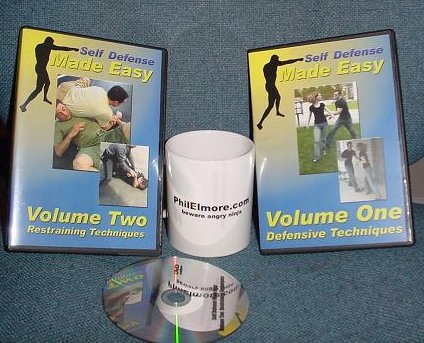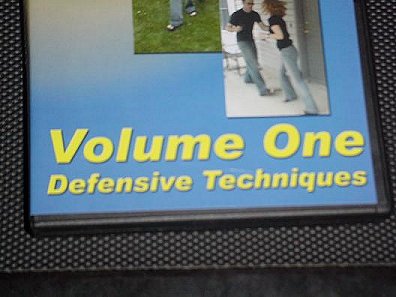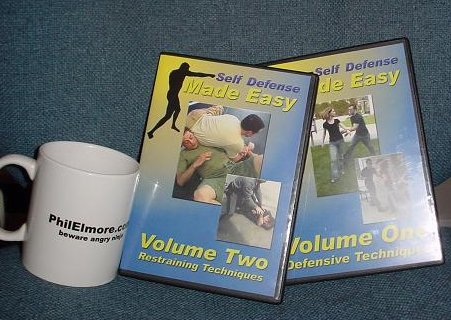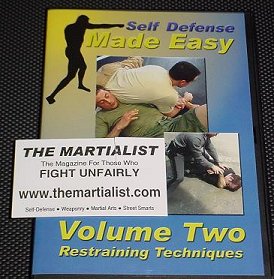its paid sponsors, whose products you need!
| Home |
| Intro |
| Current Issue |
|
Mailing List |
| Store |
| Strength |
| Subscriber Content |
| ARCHIVES
|
| Martialism |
| Pacifism |
| Q & A |
| Cunning-Hammery |
| Advertise With Us |
| Submit An Article |
| Staff |
| Discussion Forum |
| Links |
“Stay ‘unreasonable.’ If you
don’t like the solutions [available to you], come up with your
own.”
Dan Webre
The Martialist does not
constitute legal advice. It is for ENTERTAINMENT
PURPOSES ONLY.
Copyright © 2003-2004 Phil Elmore, all rights
reserved.
Self-Defense Made Easy
A Review by Danny “Spanky” Rowell
It has long been my opinion that self-defense is more about
mindset than physical technique. I have studied many arts looking for common
foundational principles. When I found out that someone had finally included
the excellent techniques of Brazilian Jiu-Jitsu in a self-defense video, I
immediately purchased a copy. Specifically, I bought Self Defense
Made Easy, a two volume set recently released by
New York
Martial Arts Gym.

Volume 1 is Defensive Techniques. The
DVD is about 60 minutes long and is divided into 5 sections. Segment 1 deals
with attacks from behind. Gene Simco outlines one specific technique (a
front hip drop, using Kantan terminology) that can be used for almost
every type of grappling attack from the rear. When grabbed, you step to the
side to create a small amount of working space, then move your inside leg
behind your attacker. Placing your hips behind his, you go to the
ground.

I can hear it now
“Spanky, you dont want to
go to the ground in self-defense, ever!” Well, dear reader, Ive trained with
quite a few self-defense instructors and each one, to a man, has taught me
techniques to get my opponent on the ground. Generally you prefer not to go
with them, but sometimes its a good idea. That is exactly what Simco
teaches with this front hip drop. You take your opponent to the ground in a
simple but effective technique. You take him there hard and you land on top of
him. I know from experience that this type of move hurts on the mats. I can
only imagine how much fun it is on asphalt.
“But Spanky, youre still on the ground.” Not for long, amigo. The next
technique Simco discusses is how to get right back up, standing, in a position
where youre ready to fight or run.
Segment 2 discusses how to deal with common attacks from the front. Gene
outlines the basic non-confrontational defensive posture: hands up in front,
palms out and open, one foot in front and one in back. Your elbows are
in and youre trying to deescalate the situation. If youre a student of
self-defense that has been around for a while, youll recognize this as a very
common approach to initial situational posture. Gene takes this basic stance
and adds to it from his extensive background in grappling. He uses simple
techniques that minimize your target areas while maintaining strong mobility
and facilitating easy counters.
From this single stance, Gene covers how to defend against punches (the jab,
the hook, and the cross) and how to defend against kicks. He also
demonstrates a nice maneuver used to defend against the shoot. All the
defenses are simply extensions of this one basic stance one technique used
to deal with a variety of assaults from the front.
Segment 3 is on groundfighting. After all, how can you have a BJJ DVD that
doesnt include groundfighting? Gene takes the applied techniques from the
first two sections and illustrates how you use the same foundational
principles to defend yourself on the ground and on the ground you will be.
Some time, some place, somebody is going to put you there. Simco
outlines a few good methods for dealing with that situation.

Something that really appealed to me in this
whole series is that Gene emphasizes again and again that these techniques are
not about sports and they are not about fighting. What he is trying to teach
is some very basic, universally applicable techniques that will get you out of
bad situations and on your way home, safely. Its not about who wins its
about who survives.
Segments 5 and 6 include some basic applications of the previously mentioned
techniques for dealing with knife and gun attacks. Gene points out that it is
sometimes safer to capitulate to a mugger or another bad guy if all they want
is something you can replace easily. Your wallet, cash, credit cards, and
other valuables can be replaced. You, however, cannot.
If you find yourself in a bad position and you cannot talk your way out of it
if you are forced to get physical you can apply the same basic principles
and increase your chances of survival. One comment that caught my attention
occurred when Gene talked about distance and the firearm. If someone is
skilled with weaponry and understands that pistols are distance weapons, Gene
explains, youre pretty much out of luck unless you can run away. These
defenses apply when you are dealing with someone who doesnt truly understand
the weapons he is using.
The second DVD, Restraining Techniques, is geared more towards those
occupations where restraint and containment are the norm. However, you may
have need of these in everyday self-defense as well. If youre a third party
breaking up a fight, or if you find yourself in a situation in which you want
to contain your attacker until help arrives, this is a good DVD to have.
 Following
Following
the pattern set in the first DVD and often referring to Defensive
Techniques, Gene discusses how to contain someone while standing or on the
ground. To begin, Gene covers two approaches to getting in and getting close
to your attacker. From there the technique branches off into restraining the
attacker while he is still standing. With strong emphasis on position and
mechanics, Gene encourages the use of technique over strength or speed. While
you may become gassed and your muscles may become fatigued, your brain never
stops working. Use it.
Gene talks at length about the use of the rear naked choke (RNC). The viewer
is treated to a snippet of one of NYMAGs Brazilian Jiu-Jitsu training DVDs
that outlines the proper approach to and technique of the rear naked choke.
Gene also adds a nasty little cross-face neck crank to encourage your attacker
to comply. Its effective technically and its quite painful to boot.
Simco takes some time in the middle of the DVD to discuss the RNC, its extreme
effectiveness as a finisher, and its application. Gene also discusses, at
length, the moral, legal, and physical consequences of choking your attacker.
You can use the naked choke, and sometimes you must, but its
probably not your first choice in self-defense situations. (Sounds somewhat
familiar, no?) Gene does a great job
outlining the pros and cons of using the choke.
The final segment of DVD 2 discusses restraint on the ground. The K.I.S.S.
principle that has been used to good effect all through the series is even
more applicable to this segment. Gene recommends the Kimura as a good,
high percentage lock on the ground and discusses many different angles of
setup and execution.
The audio and video quality of both DVDs is top notch. There were a few
glitches in the beginning and ending sequences, but only one sync spot during
actual technique training. Written graphics that point out warnings,
additional tips, and specific definitions appear on your screen when
appropriate. Video footage of the techniques being used in mock real life
situations gives the viewer some insight into how they would be used on the
street.
The Self Defense Made Easy series is written, produced, directed by,
and stars Gene Simco. The delivery is 99% smooth and the flow is
constant and upbeat. You can tell that Gene knows his stuff and is an
excellent teacher. As always, Gene
backs up his products
and his staff provides excellent customer service. I express-ordered my copies
and received them the very next day. Everything was as it should be and Im
one happy customer.
For anyone who has BJJ, Judo, Wrestling, or other grappling experience, this
is an excellent resource in applying what you know to self-defense situations.
Even if you dont have such a background, you can still learn and use these
simple techniques in self-defense.
I highly recommend this
series.
